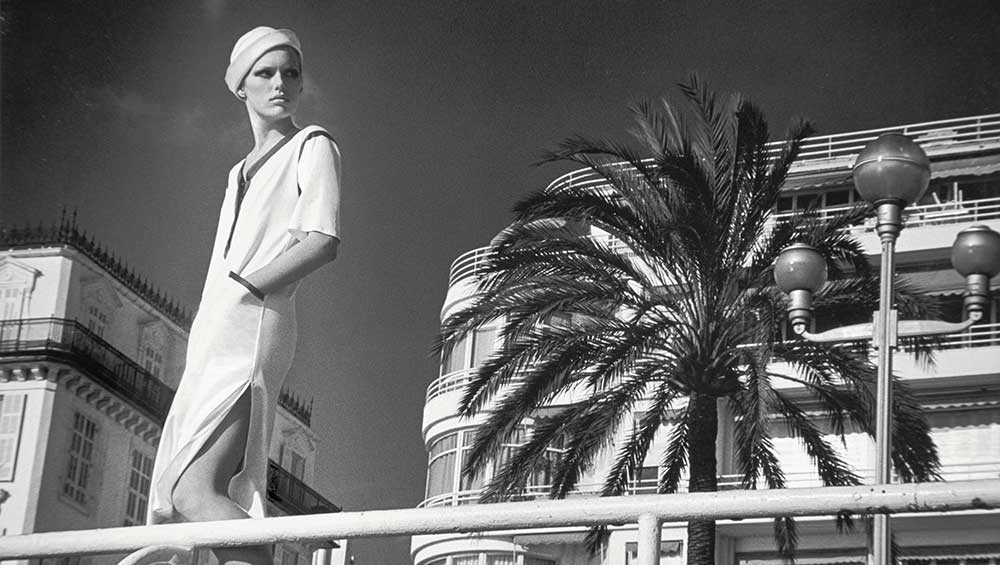
Helmut Newton. Patti Hansen in Yves Saint Laurent, Promenade des Anglais, Nice 1976. © Helmut Newton Foundation, courtesy Condé Nast.
Helmut Newton Foundation, Museum für Fotografie, Berlin
15 February – 20 May 2024
by SABINE SCHERECK
Dreams on paper, printed in thousands and distributed across the United States: elegant robes, Hollywood glamour and lifestyle ideas were the stuff of Vogue magazine. Condé Nast had turned the small New York society publication into an international success after he bought it in 1909. Together with Vanity Fair, also under Nast’s leadership, it featured the great and good of the cultural elite, shot by photographers who were masters of their craft: Cecil Beaton, Edward Steichen, Horst P Horst, George Hoyningen-Huene, Lee Miller, Irving Penn and Helmut Newton among many others.
Fast forward to 2021: the French billionaire and Gucci owner François Pinault acquired works from the Condé Nast Archive and made them part of his 3,000-piece art collection. With the exhibition Chronorama: Photographic Treasures of the 20th Century, he presented his new acquisition to the public at his Palazzo Grassi in Venice last year. Of the more than 400 works displayed at the palazzo, 270 have now travelled to Berlin where they can be admired at the Helmut Newton Foundation at the Museum for Photography – a fitting place considering Newton’s photographs are also part of the collection.
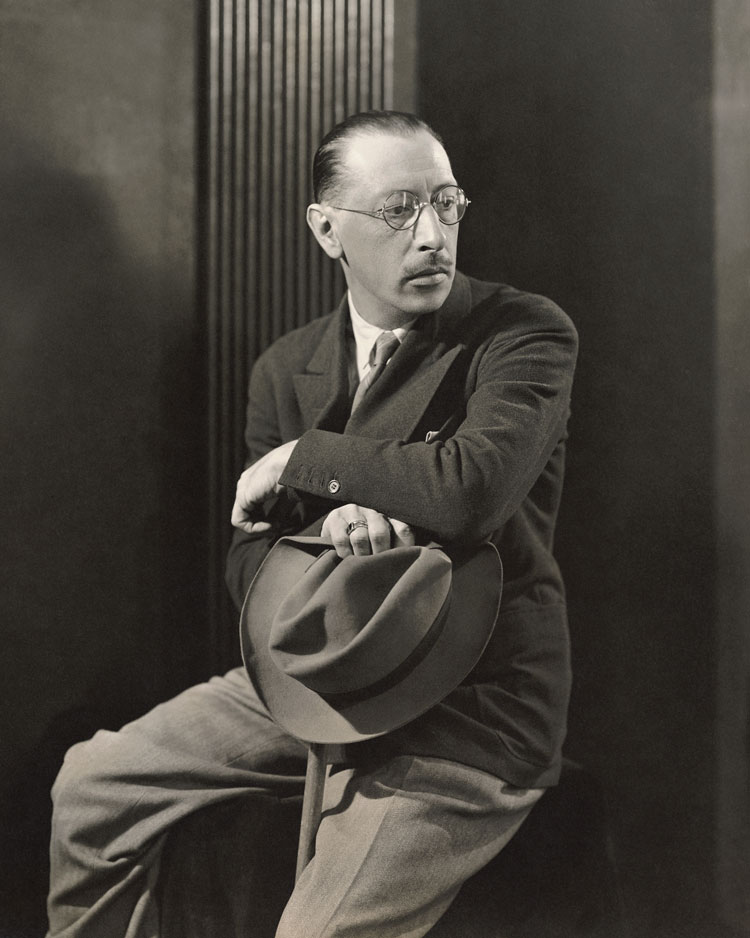
George Hoyningen-Huene. Igor Stravinsky seated with a hat, Vanity Fair, 1927. © Condé Nast.
The exhibition begins with fashion illustrations of the 1910s and early fashion photographs from that period. From there, it journeys through the decades up to the 1970s. It is an arresting encounter with the past century. Each picture is a window into a bygone era, reminding us how style was defined then, not only in the US but also in Britain and France, where national editions of Vogue were produced from 1916 and 1920, respectively.
The cover illustration from 1910 by Davis, Woman Sitting in Front of a Vanity, Putting on Make-Up, clearly marks what this magazine was about and who it was aimed at. It depicts a young woman smiling, wearing an elaborate hat and a rose-coloured dress that flows on to the floor. This magazine was for the well-to-do in whose social sphere style played a crucial part. This becomes even more evident in Jessie Gillespie’s cover from 1911, Vogue Announces the Spring and Summer Fashions, on which silhouettes of women with desirable slimline dresses and impressive hats are lined up. With this in mind, and knowing in which direction the shapes of the dresses of the 1920s were heading, it is a surprise to see illustrations from 1916 that do not conform to this. Helen Dryden’s Woman Standing on a Gondola and Rita Senger’s Woman Wearing a Black Pouffy Gown dream up billowing dresses. The latter, with its low shoulders, is reminiscent of the 1830s. Magazines on display from 1916 and 1917 show further illustrations and photographs, which give a clearer idea of what ladies wore at that time.
![Adolph de Meyer. Young Girl Sitting [on a Small Table] Beside a Globe, Vogue, 1919. © Condé Nast.](/images/articles/c/&080-chronorama-2024/04_Adolf-de-Meyer,-Young-girl-sitting-on-a-small-table-beside-a-globe,-Vogue,-1919,-copyright-Conde-Nast.jpg)
Adolph de Meyer. Young Girl Sitting [on a Small Table] Beside a Globe, Vogue, 1919. © Condé Nast.
On one wall is a particularly striking image, which offers an insight into early fashion photography: Adolph de Meyer’s Young Girl Sitting [on a Small Table] Beside a Globe (1919). Her stern straightforward, self-assured look matches that of any adult model of today. Her blond pageboy haircut makes her even more modern. De Meyer was the first official fashion photographer for Vogue. His significance for the magazine is briefly mentioned in one of the accompanying wall texts, which sketch the major events of each decade. However, since De Meyer paved the way for fashion photography after having taken up his post at Vogue in 1913, it would have been interesting to learn more about him, and about some other key photographers too.
De Meyer was born in Paris in 1868 to a German Jewish father and a Scottish mother. He was made a baron in 1897 and lived in London before relocating to New York at the beginning of the first world war. He moved in the same social circles as most of his sitters, for whom the magazine was designed. His fellow Vogue photographers Beaton and Hoyningen-Huene came from similar privileged backgrounds, but it was not a prerequisite to work for this upmarket magazine. For example, Steichen and Penn’s parents were immigrants who had come from Europe to the US at the turn of the 19th century to seek a better life.
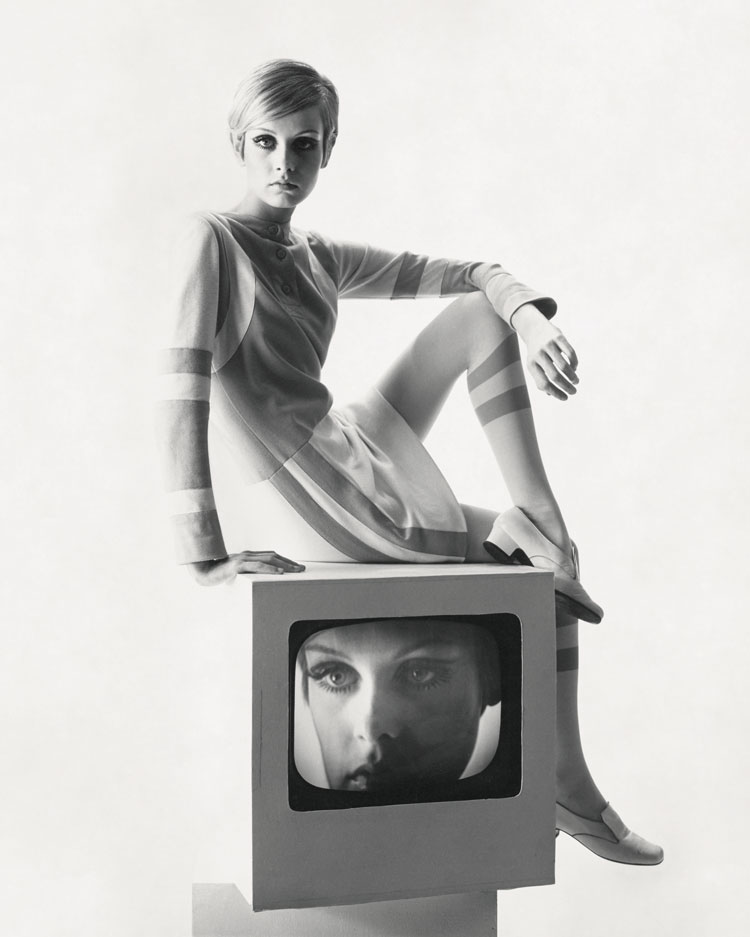
Bert Stern. Twiggy wearing a mod minidress by Louis Féraud, and leather shoes by François
Villon, Vogue, 1967. © Condé Nast.
One picture that stands out from the selection of serene studio portraits of the 1920s is that of the German sculptor Renée Sintenis by Steffi Brandl in 1929. Sintenis’s work was shown at the Museum of Modern Art in New York during these years, which might have been the occasion for featuring the Berlin-based artist in the magazine. But again, there is no explanation as to how this image became part of the Condé Nast Archive, other than that Vogue strove to be modern and Sintenis was clearly that. Her hair is cut as short as a man’s, her features, too, resemble that of a young lad. In addition, her stripy long-sleeved T-shirt betrays nothing of its era nor does it give any hint of femininity. Its modern androgynous look is mind-blowing and it is easy to believe the photo could have been taken today. This is also supported by the white background as opposed to the black background found on many other portraits of the time.
Noteworthy also is Steichen’s portrait of Lee Miller from 1928. She appears to be sitting on a chair outdoors with ivy leaves in the background, yet the lighting suggests something different. What makes the picture so remarkable is that Miller simply sits up straight in a summer dress facing the camera. Her expression is calm and the whole setting conveys the idea of “no great fuss”, compared to many other elaborately staged portraits such as Steichen’s 1931 image of the American Dance Group Albertina Rasch Girls, which emanates pure glamour.
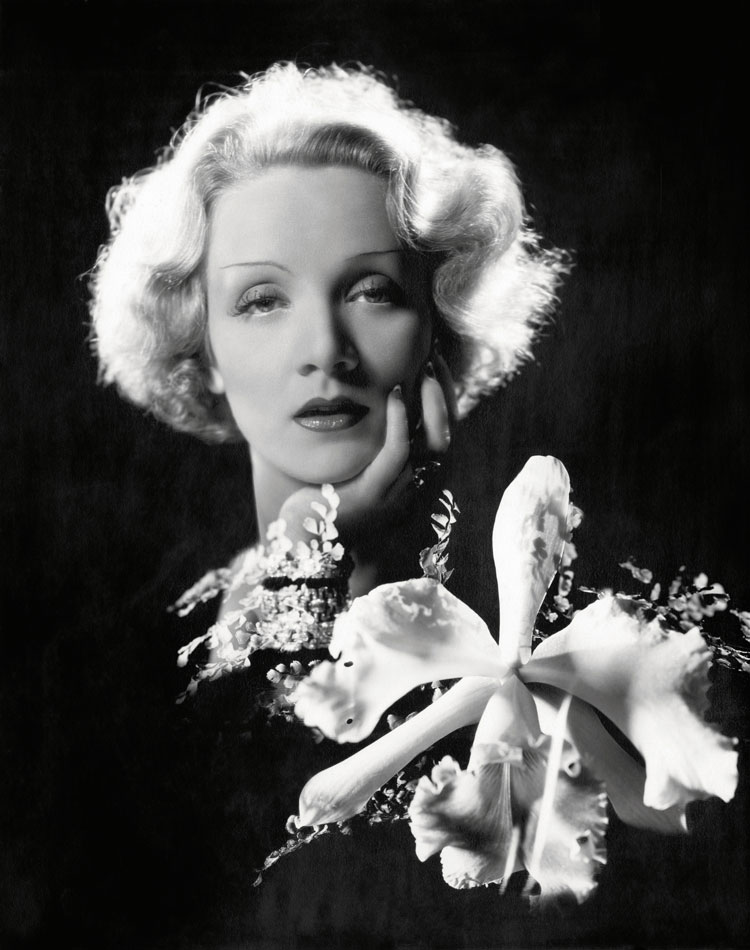
Cecil Beaton. Actress Marlene Dietrich, Vanity Fair, 1932. © Condé Nast.
In the face of the 1930s depression, the desire for glamour was growing and with Hollywood producing more stars, this meant more images, still and moving, to inspire dreams. A classic picture within this section is Cecil Beaton’s 1932 portrait of Marlene Dietrich with her blond wavy hair glowing against the pitch-black background and a white orchid on the bottom right. The orchid encapsulates beauty, luxury and, considering its exotic origin, something out of reach. Equally out of reach was the fun that the higher echelons of society had when Margaret Bourke-White captured the young sporty women shown in Tennis Players on a Rooftop in Front of the Manhattan Skyline (1931). This outdoor scene is a step on the path to present the world outside the photographic studio.
This becomes more prominent in the 1940s when the magazine brings images of war-torn Europe to its readers. For Beaton, who for decades had created scenes of style and beauty, this meant being assigned to document the rubble and ruins of London. Even more fascinating is Miller’s path: from starting as a model at Vogue, she switched sides to establish herself as a photographer. She, too, left safety and glamour behind to report on the raging war in Europe. Here on display is the photograph Fall of the Citadel of Saint-Malo in France in 1944, which, taken through a bombed-out window, caught an explosion on camera.
On the same wall, like a counterpoint to the destruction and turmoil, are images of neat interior designs. One is that of the Bauhaus architect Walter Gropius and his wife, Ise. Home of Walter and Ise Gropius, Lincoln, Massachusetts was taken by Robert M Damora in 1948. Considering they had fled Nazi Germany in the 1930s and brought the ideas of the Bauhaus design to the US, their home would have been of interest to the public. The room seems to be the couple’s office with a typewriter, a telephone, a long table and two chairs. Piles of papers and photographs suggest busy owners.
Another poignant picture from that period is Frances McLaughlin-Gill’s portrait Richard Rutledge Sitting in a Vogue Studio (c 1949). It is taken from above and depicts Rutledge, wearing a suit and a tie, in a rather twisted, uncomfortable position. His expression, unsurprisingly, is not necessarily relaxed. For the viewer, this sums up the postwar frame of mind within a now distorted world. Here, too, it is worth digging deeper. Although the label marks Rutledge as a US photographer, there is no mention of the fact that he was a prolific fashion photographer at Vogue and had a major impact on how the New Look, coming from Dior in Paris, was presented to the public.
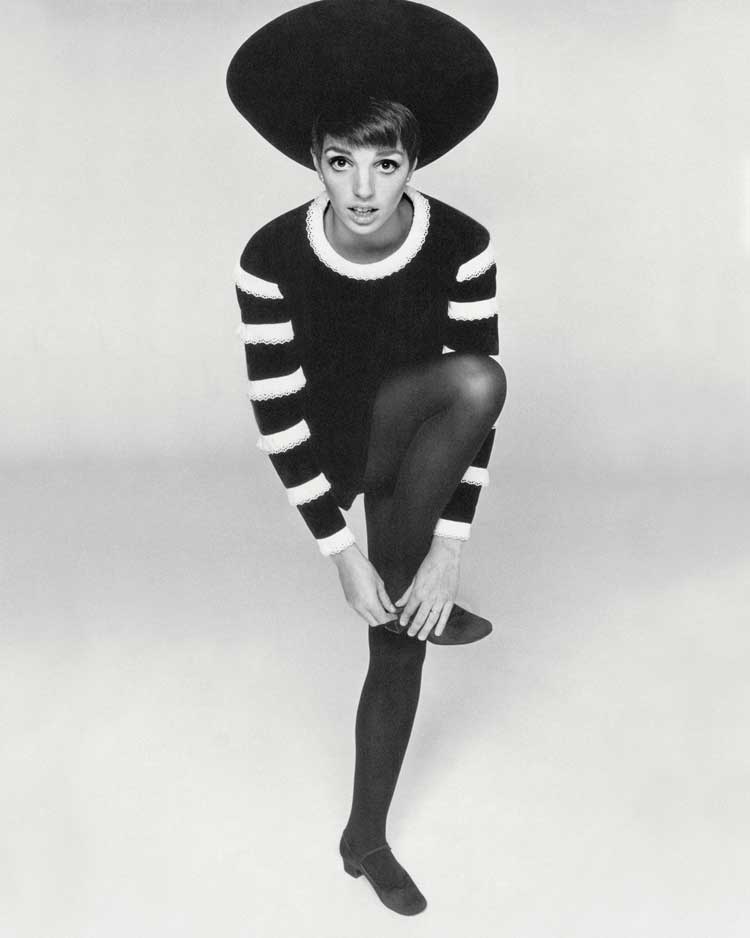
Alexis Waldeck. Actress-singer Liza Minnelli, Vogue, 1967. © Condé Nast.
The images of the 1950s and many of the 1960s sections just slide by. More works of architecture fill the walls, and sitters take on more casual poses. Pop stars such as the Beatles and Mick Jagger find entry into the magazine. There are two photographs that make the viewer pause. First, a studio portrait of Jean Shrimpton and Sammy Davis Jr from 1965 by Bert Stern. While Davis Jr, in a black suit, lies belly-down on the floor laughing, Shrimpton, in a slimline long white dress, reclines against him with a calm look. What led to the American entertainer and British model being photographed together? No information can be found, but they form an intriguing combination. Second, a studio shot of a young Liza Minnelli in a fashionable short dress, taken by Alexis Waldeck in 1967. Instead of striking a pose, she is captured in motion lifting her foot to do up the buckle of her shoe. At the same time, her eyes remain in contact with the camera, which creates a refreshingly natural scene as if she were talking to the photographer.
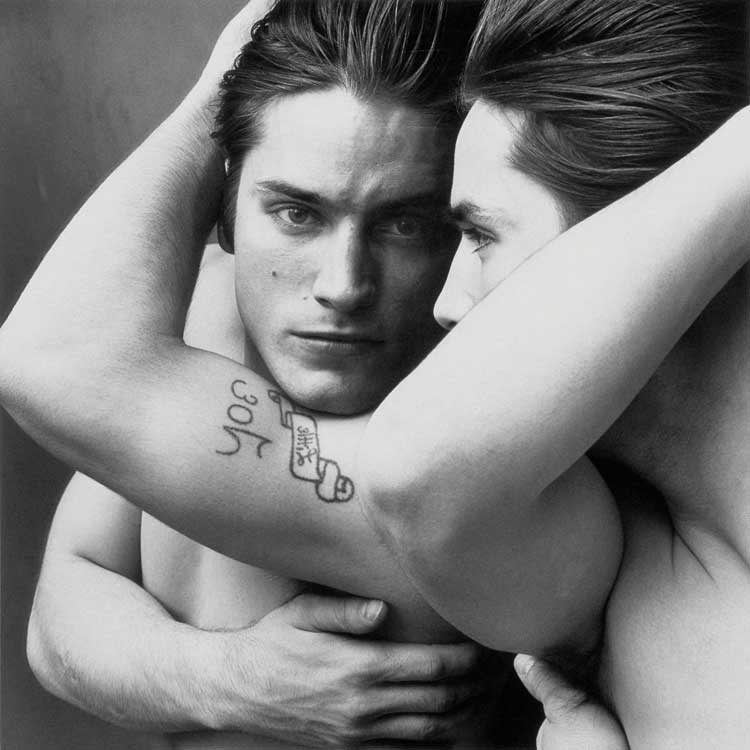
Jack Robinson. Actor Joe Dallesandro, Vogue, 1970. © Condé Nast.
The 1970s present a very different narrative: naked skin, eroticism and strong women dominate the imagery. Among them: Duane Michals’ Two Models in an Office Looking at Negatives from 1976. Their posture and discerning look indicate professionals, working women – women, who are active and not passive objects of beauty, who are just gazed at. There is also Jack Robinson’s portrait from 1970 of the American actor Joe Dallesandro, who is posing bare-chested so close to a mirror that it almost looks as if there are two people. Despite Dallesandro’s intense look at the viewer via the mirror, the fit young man looks lost in thought.
Newton’s Patti Hansen in Yves Saint Laurent, Promenade des Anglais, Nice (1976) also catches the eye because the long, straight dress is reminiscent of the 1920s. The sailor’s hat, too, is a nod to the cloche hats worn during that period. In the 1970s, creatives looked back at the 1920s in many ways – think of the 1972 film Cabaret conjuring up 1920s Berlin on the screen. But there is more to it. Newton himself was a child of the period. Born in 1920 in Berlin, he received his professional training from the fashion photographer Yva before he fled Nazi-Germany in 1938.
This exhibition, curated by Matthieu Humery from the Pinault Collection and Matthias Harder, director of the Helmut Newton Foundation, is a celebration of the golden age of photography. It enables the visitor to revisit the last century through the eyes of those who lived in comfort and, as explained in the introductory text: “These photographic treasures represent a very specific and subjective historical image that reflects the western cultural and financial elite.” Nonetheless, a bit more background information behind the works and their creators would have been welcome, including the note that the exhibition ends in 1979 for the simple reason that the picture rights changed in the US that year: photographers were allowed to own the original print.
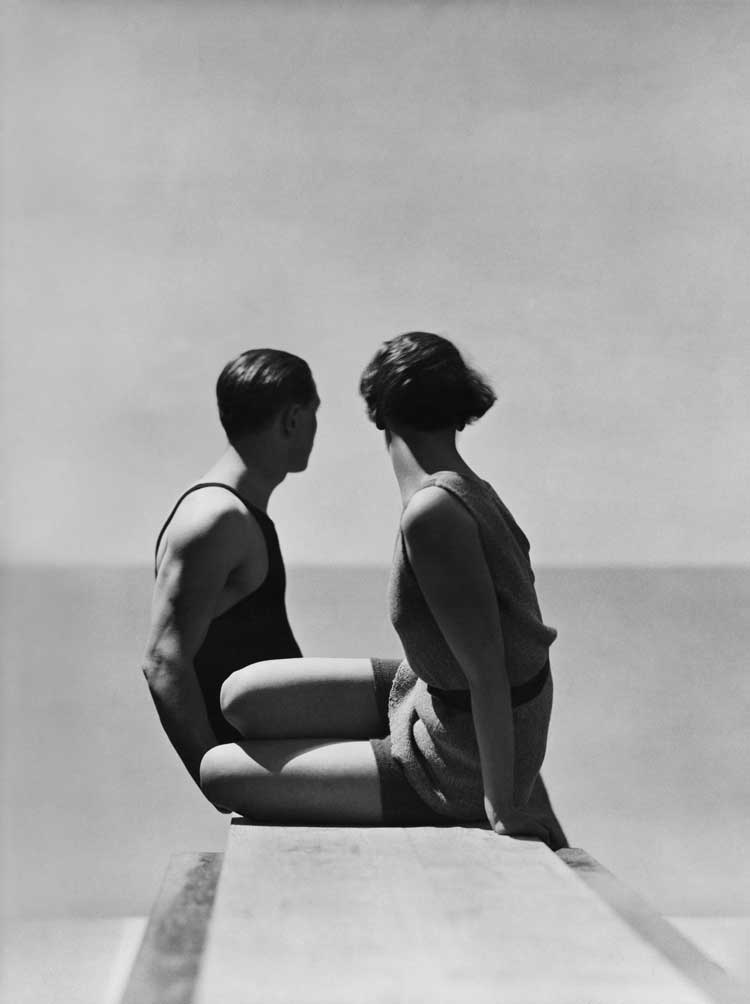
George Hoyningen-Huene. Divers, swimwear by A. J. Izod, 1930. © George Hoyningen-Huene Estate Archives.
A good companion exhibition to Chronorama is George Hoyningen-Huene – Glamour & Style, at the Jaeger Art Gallery in Berlin, which runs until 23 March. Hoyningen-Huene’s work is also featured in Chronorama but has rarely been the sole subject of an exhibition. The gallery presents works from the 1920s to 1960s, including the famous Divers, Swimwear by Izod (1930), which shows a man and a woman side on, sitting on what seems to be a springboard by a pool or a lake. In fact, Hoyningen-Huene was a very resourceful photographer and took the image of Lee Miller and Horst P Horst on the roof of the Vogue studio on the Champs-Élysée in Paris. Fashion and Hollywood were his passions. Besides portraits of Charlie Chaplin, Marlene Dietrich and Greta Garbo, there are two stunning discoveries. One is Lee Miller, Sailcloth Overall by Yrande (1930), the other Mme Georges Auric, Two-piece by Tao-Tai, French Riviera (1932). Although neither model looks at the viewer, the images have a magnetic-like power. Both women have short hair, which is almost fixed to the head. They wear long comfortable trousers and stand upright in a way that shows they are in command of the scene. This command makes them very modern, but it is the combination with their grace that makes these pictures so appealing. It is a joy to see this first-class, long-overlooked photographer getting the attention he deserves. He also had a fascinating life that is explored in Susanna Brown’s book George Hoyningen-Huene, which is published by Thames & Hudson in April 2024.
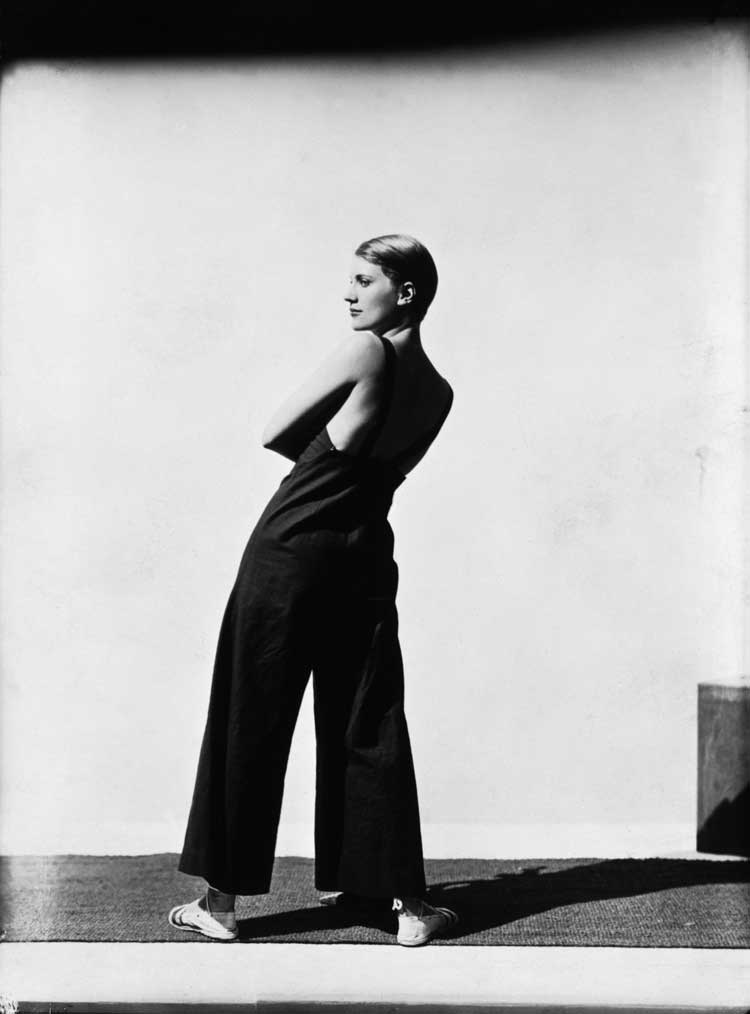
George Hoyningen-Huene. Lee Miller, 1930. © George Hoyningen-Huene Estate Archives.